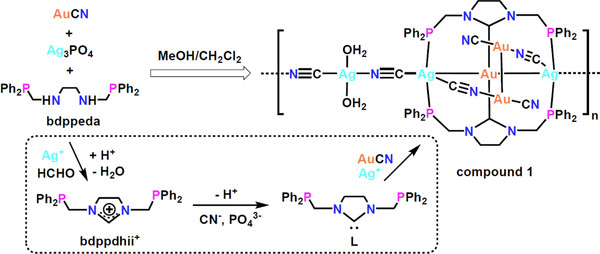Aggregation-Induced Emission Phosphorescence Featured Au-Ag Coordination Polymer with a Diphosphine N-Heterocyclic Carbene Ligand for Highly Sensitive Detection of Cr(VI)
Sisi Yan1, Yuanyuan Hu1, Lin Cui1, Mengyao Feng1, David James Young2, Hong-Xi Li1, Xuewen He1(何学文)*, Chengrong Lu1(陆澄容)*, Zhi-Gang Ren1(任志刚)*
1Suzhou Key Laboratory of NovelSemiconductor-Optoelectronics Materials and Devices, Collegeof Chemistry, Chemical Engineering and Materials Science,Soochow University, Suzhou 215123 Jiangsu, People’sRepublic of China
2Glasgow College UESTC, University of Electronic Science and Technology of China, Chengdu 611731, People’s Republic of China
Inorg. Chem. 2024, 63, 14415−14424
Abstract: Luminescent materials with aggregation-induced emission (AIE) characteristics have been recognized as highly selective and sensitive probes for the detection of toxic metal ions in recent years. In this paper, a Au–Ag cluster-based coordination polymer [Au3Ag3(L)2(CN)6(H2O)2]n [1, L = 1,3-bis((diphenylphosphanyl)methyl)-4,5-dihydro-imidazolylidene] was prepared by in situ generation of the diphosphine N-heterocyclic carbene (PCNHCP)-type ligand L in the presence of the corresponding metal salts. Compound 1 exhibited 530 nm phosphorescence under 380 nm excitation with a QY of 6.30% and a lifetime (τ) of 7.14 μs in the solid state. 1 showed good AIE behavior in the mixture of MeOH/H2O while the best aggregation state (fwater = 90%, QY = 6.79%, τ = 6.70 μs) exhibited selective and sensitive emission quenching toward Cr(VI) ions. Ultralow detection limits of 9.7 ppb (w/w) for Cr2O72– and 17.9 ppb (w/w) for CrO42– were achieved.

链接://pubs.acs.org/doi/10.1021/acs.inorgchem.4c01340